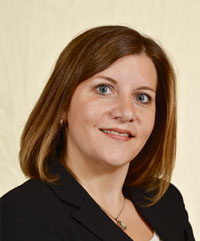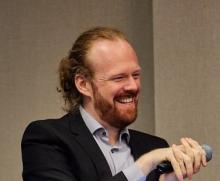Lisa DeFrancesco, vice president of IR at Actavis, talks about executive commitment, getting investors to stick and knowing when to say no
Last year, under the name of Watson Pharmaceuticals and before acquiring the Swiss firm that now lends its name to the company, Actavis finished outside the top 50 US companies in the IR Magazine rankings.
Now, in 2014, the firm has climbed to finish in 39th spot, while Paul Bisaro, Actavis’ CEO for almost seven years, has taken home the trophy for best IR by a CEO or chairman at a mid-cap company. Lisa DeFrancesco, the company’s chief IRO, says such recognition is indicative of the top-down importance IR is given at the pharmaceuticals company.
What sets apart Actavis’ IR program from the crowd?
First would be our reporting structure: as part of a comprehensive group reporting into the COO and then into the chairman and CEO, our department is part of the larger corporate communications structure, which also incorporates internal communications, PR and government affairs. Under this umbrella, we deliver the same message to investors, analysts, media, employees, legislators and customers. It’s very powerful.

Lisa DeFrancesco
'Communicating our strategy has been a critical part of our success'
Our IR program is focused on reaching and retaining our top shareholders, and then on attracting new investors, particularly outside of the US where we have room to grow. We try to attend at least one conference per quarter to ensure we have a fresh voice out there, but non-deal roadshows are what we find most productive.
We also do a lot of site visits where investors come to the office as a group hosted by the sell side. I try to use different sell-siders all the time and to make an effort to compensate those who work hard by rewarding them with being able to bring a group to our office. It’s important to change things, and not to be afraid to say ‘no’ if it doesn’t make sense for the company or for management.
This year marks Actavis’ return to the top 50 US companies in the IR Magazine rankings. What changes have you made to the IR function over the past year?
Communicating our strategy effectively has been a critical part of our success. With our share price up almost 500 percent in the last four and a half years and the company undergoing significant growth and change, we have really focused on carrying the investor base through this evolution.
For example, we have made a number of large transformational acquisitions, and we approach each transaction we go through with an M&A analysis of potential impact on the shareholder base. This helps to prepare our communications to ensure our shareholders can anticipate the change.
Also, being able to think ahead to what the company is becoming and what kind of shareholder base is appropriate for the future have been essential components in avoiding potential bumps in the road.
Remarkably, it has worked: our investors have stuck by us and our market cap has grown from less than $10 bn four years ago to around $32 bn today. During this time we have kept most of the same – very happy – investors within our top 25.
Investors still support our management team and believe in the future growth of the company. We have started each of the last five years with an investor day, giving disclosure that sets the stage for the year and providing the material needed to communicate with investors about our story.
We have also made significant changes to our vendors to ensure we have the right support in place to be effective.
Does IR have wider strategic importance at Actavis?
Creating and enhancing shareholder value is the focus of the management team and IR is often asked to provide feedback on many different business-related decisions. Because we are so active with investors and analysts, management is very aware of the investment community’s position on many subjects.
This creates an environment where, because that level of awareness exists, management doesn’t always have to consult me to have that perspective before making decisions.
How active a role does Actavis’ CEO, Paul Bisaro, have in your investor relations program?
I’m fortunate to have a management team that really focuses on creating value for shareholders. Paul is very active regarding our investor base. If there is an event or issue that needs to be communicated to shareholders, we always talk briefly about my approach as the shareholders matter to him.
Our management team takes the commitment it makes to shareholders – to execute on our goals and objectives – very seriously, and it pays dividends when the whole team has that focus. Our management team has earned trust from the investment community over the last several years by making commitments and continuously meeting or exceeding investor expectations.
What new tools or technology have you employed recently?
We use Ipreo for surveillance and we do supplemental targeting including return-on-investment reports for management. We have used Ipreo for transaction support, too, which has really made a difference to our approach over the last couple of years.
We also just recently made room in our budget for a Bloomberg terminal, which allows us to pull more real-time data on court cases, prescription data and other industry-related subject matter without having to burden our internal teams, which are focusing on the day-to-day business. This has really improved our ability to stay ahead of the Street within a very dynamic, news-driven industry.
What kinds of investors comprise your typical shareholder base?
We’re predominantly institutionally held: our top shareholders are Fidelity, Wellington, Lord Abbett, TIAA-CREF and Franklin Advisors. Over the last two years I’ve also experienced a new trend that has taken some getting used to: because of our strategy, which includes growth through M&A, I have seen a few large hedge funds become part of our top 10.
As I come to know them, I am comfortable they are taking a long-only approach to our stock. Their ownership fluctuates, but they have remained fairly consistent holders and I think it is reflective of what is actually happening on the Street today, where hedge funds have learned that in markets following 2007 you have to take a long-only approach, at least within parts of your investments, in order to make money. I’ve grown to know the analysts and portfolio managers well and I am very comfortable with their ownership of our stock.
What is the question investors have fielded most often this year?
In our industry this year M&A is definitely the biggest focus. We have a great free cash flow profile and our leverage is rapidly declining, so the big question is: what will you buy next?
What were Actavis’ biggest IR challenges in the last 12 months?
It’s been the same challenge I’ve had over the last three years, really, and that’s retention. In the face of large, transformational M&A, retention is challenging, particularly when the strategies of the two companies involved are slightly different. In our most recent transaction we were able to retain more than half of the top 10 holders of the acquired company one year later, which I consider to be a great accomplishment.
Everyone knows us within the industry and we are widely held. We still meet with the institutions that don’t own us, but if they didn’t own us two years ago, chances are low they are going to turn. That means we constantly have to retain and expand our existing shareholder base and capitalize on opportunities to expand it outside of the US, where we have new interest.
It’s challenging – we have to consistently communicate and make sure they see our growth strategy is intact and that we have many prospects for continued growth.










